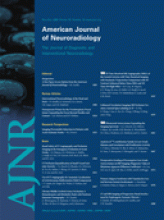Abstract
BACKGROUND AND PURPOSE: Time-resolved MR angiography (MRA) offers the combined advantage of large anatomic coverage and hemodynamic flow information. We applied parallel imaging and time-resolved imaging with stochastic trajectories (TWIST), which uses a spiral trajectory to undersample k-space, to perform time-resolved MRA of the extracranial internal carotid arteries and compare it to time-of-flight (TOF) and high-resolution contrast-enhanced (HR) MRA.
MATERIALS AND METHODS: A retrospective review of 31 patients who underwent carotid MRA at 1.5T using TOF, time-resolved and HR MRA was performed. Images were evaluated for the presence and degree of ICA stenosis, reader confidence, and number of pure arterial frames attained with the TWIST technique.
RESULTS: With a consensus interpretation of all sequences as the reference standard, accuracy for identifying stenosis was 90.3% for TWIST MRA, compared with 96.0% and 88.7% for HR MRA and TOF MRA, respectively. HR MRA was significantly more accurate than the other techniques (P < .05). TWIST MRA yielded datasets with high in-plane spatial resolution and distinct arterial and venous phases. It provided dynamic information not otherwise available. Mean diagnostic confidence was satisfactory or greater for TWIST in all patients.
CONCLUSION: The TWIST technique consistently obtained pure arterial phase images while providing dynamic information. It is rapid, uses a low dose of contrast, and may be useful in specific circumstances, such as in the acute stroke setting. However, it does not yet have spatial resolution comparable with standard contrast-enhanced MRA.
- Copyright © American Society of Neuroradiology












